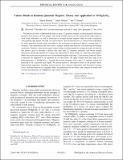| dc.contributor.author | Senthil, T. | |
| dc.contributor.author | Kimchi, Itamar | |
| dc.contributor.author | Nahum, Adam | |
| dc.date.accessioned | 2018-07-31T14:25:00Z | |
| dc.date.available | 2018-07-31T14:25:00Z | |
| dc.date.issued | 2018-07 | |
| dc.date.submitted | 2018-04 | |
| dc.identifier.issn | 2160-3308 | |
| dc.identifier.uri | http://hdl.handle.net/1721.1/117213 | |
| dc.description.abstract | We analyze the effect of quenched disorder on spin-1/2 quantum magnets in which magnetic frustration promotes the formation of local singlets. Our results include a theory for 2D valence-bond solids subject to weak bond randomness, as well as extensions to stronger disorder regimes where we make connections with quantum spin liquids. We find, on various lattices, that the destruction of a valence-bond solid phase by weak quenched disorder leads inevitably to the nucleation of topological defects carrying spin-1/2 moments. This renormalizes the lattice into a strongly random spin network with interesting low-energy excitations. Similarly, when short-ranged valence bonds would be pinned by stronger disorder, we find that this putative glass is unstable to defects that carry spin-1/2 magnetic moments, and whose residual interactions decide the ultimate low-energy fate. Motivated by these results we conjecture Lieb-Schultz-Mattis-like restrictions on ground states for disordered magnets with spin 1/2 per statistical unit cell. These conjectures are supported by an argument for 1D spin chains. We apply insights from this study to the phenomenology of YbMgGaO_{4}, a recently discovered triangular lattice spin-1/2 insulator which was proposed to be a quantum spin liquid. We instead explore a description based on the present theory. Experimental signatures, including unusual specific heat, thermal conductivity, and dynamical structure factor, and their behavior in a magnetic field, are predicted from the theory, and compare favorably with existing measurements on YbMgGaO_{4} and related materials. | en_US |
| dc.publisher | American Physical Society | en_US |
| dc.relation.isversionof | http://dx.doi.org/10.1103/PhysRevX.8.031028 | en_US |
| dc.rights | Creative Commons Attribution | en_US |
| dc.rights.uri | http://creativecommons.org/licenses/by/3.0 | en_US |
| dc.source | American Physical Society | en_US |
| dc.title | Valence Bonds in Random Quantum Magnets: Theory and Application to | en_US |
| dc.type | Article | en_US |
| dc.identifier.citation | Kimchi, Itamar, Adam Nahum and T. Senthil. "Valence Bonds in Random Quantum Magnets: Theory and Application to YbMgGaO₄." Physical Review X 8 (2018), 031028. | en_US |
| dc.contributor.department | Massachusetts Institute of Technology. Department of Mathematics | en_US |
| dc.contributor.department | Massachusetts Institute of Technology. Department of Physics | en_US |
| dc.contributor.mitauthor | Kimchi, Itamar | |
| dc.contributor.mitauthor | Nahum, Adam | |
| dc.relation.journal | Physical Review X | en_US |
| dc.eprint.version | Final published version | en_US |
| dc.type.uri | http://purl.org/eprint/type/JournalArticle | en_US |
| eprint.status | http://purl.org/eprint/status/PeerReviewed | en_US |
| dc.date.updated | 2018-07-29T18:00:20Z | |
| dc.language.rfc3066 | en | |
| dspace.orderedauthors | Kimchi, Itamar; Nahum, Adam; Senthil, T. | en_US |
| dspace.embargo.terms | N | en_US |
| dc.identifier.orcid | https://orcid.org/0000-0002-3488-4532 | |
| mit.license | PUBLISHER_CC | en_US |
